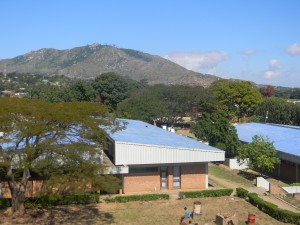A view of the Polytechnic with Mt. Soche in the background.
This past week was very busy, as the other interns and myself have started settling in and getting to work on our projects. The project of the week that took the most of our time was the bilirubin dosing meter, which measures the amount of blue light given to a patient with jaundice. Most jaundiced patients are neonatal and tend to be in a fairly fragile state, so delivering the right amount of light is necessary to ensure the baby is being adequately treated without any risk of over-exposure.
The prototype we are building is inspired by a few designs that have proliferated the global health domain. Students in last year’s GLHT 360 course had created a design based off of a design from Engineering World Health, which included a solar cell and an analog ammeter to give dosage information. A design by students at the Poly used an Arduino to display light intensity on an LCD screen, and measurements were taken with a photo-dependent resistor. It was our job to come up with a prototype based off of those that already existed that was cheap, accurate, and easy to use by healthcare workers.
Some of the decisions made in our new design were fairly easy; we chose an Arduino and digital display like the Poly’s prototype because of the inaccuracies of an analog reading, and we decided a solar cell because they had a wider resolution and were cheaper than alternatives. Other decisions though, like the shape of the device or how to ensure optimal placement, required more deliberation and creativity. It was these decisions through which our team dynamic and the diversity in our way of thinking shone through. I brought Catherine, Christina, Charles and Andrew to meet some of my acquaintances in Chathinka so we could get from them some feedback on how they normally deliver blue light therapy in the nursery, and whether they would prefer a single device containing sensor and display or whether it would be optimal to separate the two to have a display component attached to a sensor probe. This kind of feedback was so valuable because it directed our design decisions; although we had many ideas on what nurses and doctors may like best about different designs, we couldn’t really know the answer to any of our usability questions without asking the potential users themselves.
Another area that offered us some creativity in this domain was deciding how to ensure the healthcare worker was positioning the device properly. The photocell is very sensitive to minute changes in angle and positioning under the blue light. It is essential for healthcare workers to be able to easily place the device under the blue light while keeping the solar cell parallel to the ground and as close to the patient as possible.
After some brainstorming, the team decided the best way to ensure parallel angling was to include mechanical levels on the surface of the device, like those you would use to would use to hang a picture on a wall. Thinking about how to best ensure that the sensor was placed close to the patient sent us back to the drawing board for design of the device housing. Because of the addition of the mechanical levels, the idea of a probe attaching to a display was discarded. We went through a few iterations before deciding on a design that would be an elongated rectangle, with the sensor on one end and the display on the other. The length of the box allows us to keep the width fairly thin while still housing all the components, and it also gives the nurse or doctor a good view of the display while keeping the sensor close to the patient.
I really enjoyed working on the photo dosing meter with the group because it taught me so much about designing in the context of user needs, and because the creative outlets in the design process gave me insight about our team dynamic. The seven of us are very diverse, in nationality but also in engineering background and in the way we think. I thought it was very interesting to see how our differences played into the way we approached the design, and then from there to get to build our ideas and turn out an actual device that could serve a clinical purpose. I am really looking forward to the other projects we will start to now pick up.
